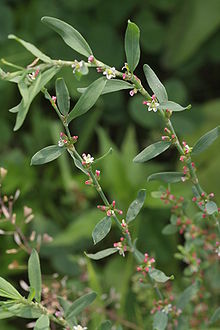Polygonum aviculare
| Common knotgrass | |
|---|---|

| |
| Scientific classification | |
| Kingdom: | Plantae |
| Clade: | Tracheophytes |
| Clade: | Angiosperms |
| Clade: | Eudicots |
| Order: | Caryophyllales |
| Family: | Polygonaceae |
| Genus: | Polygonum |
| Species: | P. aviculare
|
| Binomial name | |
| Polygonum aviculare L. 1753
| |
| Synonyms[1] | |
|
Synonymy
| |
Polygonum aviculare or common knotgrass is a plant related to buckwheat and dock. It is also called prostrate knotweed, birdweed, pigweed and lowgrass. It is an annual found in fields and wasteland, with white flowers from June to October. It is widespread across many countries in temperate regions, apparently native to Eurasia and North America, naturalized in temperate parts of the Southern Hemisphere.[2][3][4][5][6][7]
Description
Common knotgrass is an annual herb with a semi-erect stem that may grow from 10 to 40 cm (4 to 16 in) high. The leaves are hairless and short-stalked. They are longish-elliptical with short stalks and rounded bases; the upper ones are few and are linear and stalkless. The stipules are fused into a stem-enclosing, translucent sheath known as an ochrea that is membranous and silvery. The flowers are regular, green with white or pink margins. Each has five perianth segments, overlapping at the base, five to eight stamens and three fused carpels. The fruit is a dark brown, three-edged nut. The seeds need light to germinate which is why this plant appears in disturbed soil in locations where its seeds may have lain dormant for years.[3][8]
Distribution
Widespread and common in Great Britain,[9] Ireland,[9][10] and United States.[11]
Habitat
although polygonum aviculare can grow anywhere it can be particularly found in the southeastern of the united states.[10]
Chemistry
Polygonum aviculare contains the flavonols avicularin, myricitrin, juglanin,[12] astragalin, betmidin and the lignan aviculin.[13]
Cuisine
In Vietnam, where it is called rau đắng, it is widely used to prepare soup and hot pot, particularly in the southern region.
Subspecies
Polygonum aviculare has a wide distribution as an arable weed and plant of fields, shingle, sand, roadsides, yards and waste places. There is much morphological variations among different populations and several different sub-species are recognized:[1][2][3][8]
- Polygonum aviculare subsp. aviculare – very widespread
- Polygonum aviculare subsp. boreale (Lange) Karlsson – Greenland, Labrador, Newfoundland, Scandinavia
- Polygonum aviculare subsp. buxiforme (Small) Costea & Tardif – North America
- Polygonum aviculare subsp. depressum (Meisn.) Arcang. – Europe, North America
- Polygonum aviculare var. fusco-ochreatum (Kom.) A.J.Li – northeastern China, Russian Far East
- Polygonum aviculare subsp. neglectum (Besser) Arcangeli – Europe, North America
- Polygonum aviculare subsp. rurivagum (Jord. ex Boreau) Berher – Europe, North America
References
- ^ a b The Plant List, Polygonum aviculare L.
- ^ a b Flora of China, Polygonum aviculare Linnaeus, 1753. 萹蓄 bian xu
- ^ a b c Flora of North America, Polygonum aviculare Linnaeus, 1753. Doorweed, knotgrass, renouée des oiseaux
- ^ Atlas of Living Australia, Polygonum aviculare L., Wireweed
- ^ Altervista Flora Italiana, Polygonum aviculare L. includes photos and European distribution map
- ^ Lindau, G. 1894. Beiträge zur argentinischen Flora. Botanische Jahrbücher für Systematik, Pflanzengeschichte und Pflanzengeographie 19(4, Beibl. 48): 8–23 descriptions and geographic information in Latin, commentary in German
- ^ Gibbs Russell, G. E., W. G. M. Welman, E. Retief, K. L. Immelman, G. Germishuizen, B. J. Pienaar, M. Van Wyk & A. Nicholas. 1987. List of species of southern African plants. Memoirs of the Botanical Survey of South Africa 2(1–2): 1–152(pt. 1), 1–270(pt. 2).
- ^ a b "Knotgrass: Polygonum aviculare". NatureGate. Retrieved 2013-12-30.
- ^ a b Clapham, A.R. , Tutin, T.G. and Warburg, E.F. 1968. Excursion Flora of the British Isles. Cambridge Press. ISBN 0-521-04656-4
- ^ a b Parnell, J. and Curtis, T. 2012. Webb's An Irish Flora. Cork University Press. ISBN 978-185918-4783
- ^ "Knotgrass". Planteværn Online. Aarhus University. Retrieved 1 February 2016.
- ^ LC Method for Analysis of Three Flavonols in Rat Plasma and Urine after Oral Administration of Polygonum aviculare Extract. Fuquan Xu, Huashi Guan, Guoqiang Li and Hongbing Liu, Chromatographia, June 2009, Volume 69, Issue 11–12, pages 1251–1258, doi:10.1365/s10337-009-1088-x
- ^ A Novel Lignan and Flavonoids from Polygonum aviculare. Hyoung Ja Kim, Eun-Rhan Woo and Hokoon Park, J. Nat. Prod., 1994, 57 (5), pages 581–586, doi:10.1021/np50107a003
External links
- photo of herbarium specimen collected in Nuevo León in Mexico in 1989
- Howard, Michael. Traditional Folk Remedies, (Century, 1987); page 162.
